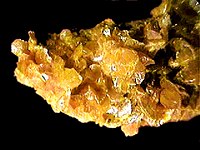
Photo from wikipedia
Abstract The establishment of non-noble metal electrocatalysts with controllable morphology is crucial significance for overall water splitting. Ni-based catalyst is perceived as a promising electrocatalyst due to its excellent oxygen… Click to show full abstract
Abstract The establishment of non-noble metal electrocatalysts with controllable morphology is crucial significance for overall water splitting. Ni-based catalyst is perceived as a promising electrocatalyst due to its excellent oxygen evolution reaction (OER) and hydrogen evolution reaction (HER) performance. Herein, β-Ni(OH)2/NF is designed for OER and HER, using a facile hydrothermal etching method. The separation rate of hydroxide is controlled by the copper-ammonium complexation reaction, and the different amounts of oleic acid is added as a protective agent to regulate the surface morphology of the Ni foam. The ingenious combination of several reactants allows us to synthesize different morphology catalysts, and get the best performance from them. The catalyst exhibits superior OER and HER electrocatalytic performance, which overpotential is 329 mV during the OER and 170 mV for the HER at 50 mA cm−2. Meanwhile, it demonstrates small Tafel slopes of 51 mV dec−1 for HER and 40 mV dec−1 for OER in 1.0 M KOH solution. Moreover, the catalyst presents a stable activity with no significant attenuation after 24 h OER and HER reaction. The hydrothermal etching method is expected to offer an adjustable synthetic strategy for the reasonable design of highly efficient, durable and non-noble-metal bifunction catalysts.
Journal Title: Journal of Electroanalytical Chemistry
Year Published: 2021
Link to full text (if available)
Share on Social Media: Sign Up to like & get
recommendations!